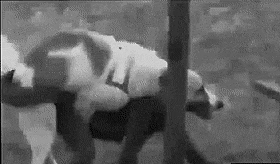Dog-monkey Hybrids
Mammalian Hybrids
Dog × Monkey
This page was a draft for a chapter on this topic that has now been published in its finished form in my book Telenothians, which is available here.
|
Cynocephales, are a kind of Apes, whose heads are like Dogs, and their other parts like a man’s; wherefore Gaza translateth them Canicipites, (to wit) dog-heads.
—Edward Topsell,
The History of Four-footed Beasts (1607) |
Monkeys have been observed mating with a wide variety of other types of animals, including dogs, a fact well attested by videos on YouTube and by information presented in the pages on primate hybridization on this website. For example, Morris reports a case of a male squirrel monkey regularly mating with a female springhare, a rodent.
Indeed, there are cases known in which non-human primates form permanent, family-like associations with dogs in the wild, such as the case documented in the following video:
In the present context, it’s interesting that the scientific name of the yellow baboon, shown in the video above, is Papio cynocephalus, an epithet that refers to its dog-like head.
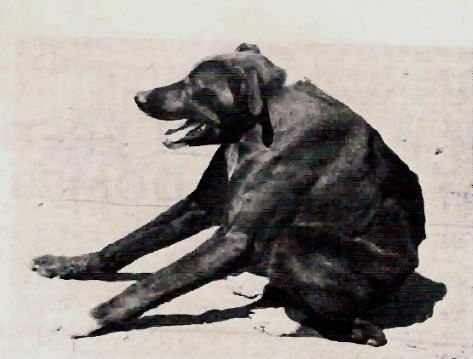 Photograph taken by Dr. H. P. A. de Boom (Veterinary Laboratory, Onderstepoort, Transvaal, S. Africa) of one of what he describes as the baboon dogs that occur with some frequency in that country. Here in the U.S. this condition is known as “short-spine disorder” and is typically attributed to mutation, not hybridity. Hutt (1964, p. 475) states that the viability of puppies with this syndrome is reduced and that male pups have not been reared. Females, however, do reach maturity and produce offspring. This distinction between the sexes in viability and fertility is consistent with Haldane’s rule and therefore with the idea that these animals are hybrids.
Photograph taken by Dr. H. P. A. de Boom (Veterinary Laboratory, Onderstepoort, Transvaal, S. Africa) of one of what he describes as the baboon dogs that occur with some frequency in that country. Here in the U.S. this condition is known as “short-spine disorder” and is typically attributed to mutation, not hybridity. Hutt (1964, p. 475) states that the viability of puppies with this syndrome is reduced and that male pups have not been reared. Females, however, do reach maturity and produce offspring. This distinction between the sexes in viability and fertility is consistent with Haldane’s rule and therefore with the idea that these animals are hybrids.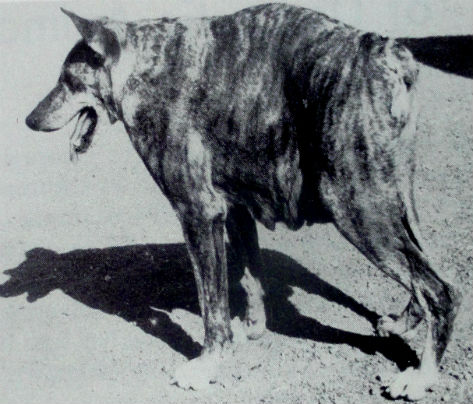 Baboon dog: Pregnant female (from Hutt 1964). The chacma baboon occurs throughout Transvaal, the state where this picture was taken.
Baboon dog: Pregnant female (from Hutt 1964). The chacma baboon occurs throughout Transvaal, the state where this picture was taken.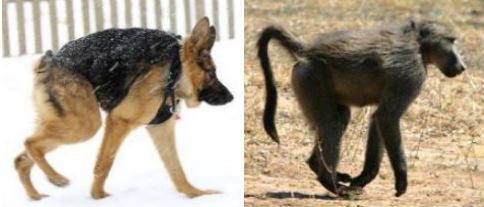 A comparison of a baboon-dog with a chacma baboon (Papio ursinus), also known as the Cape baboon, native to South Africa.
A comparison of a baboon-dog with a chacma baboon (Papio ursinus), also known as the Cape baboon, native to South Africa.
Dog-monkey hybrids: Old reports
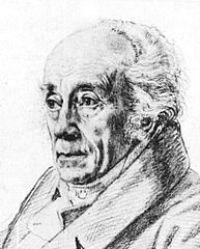 Blumenbach
Blumenbach(1752-1840)
Various older (pre-1800) accounts of dog-monkey hybrids exist. In his De generis humani varietate nativa (Blumenbach 1776, p. 11. Vol. 2, Tiguri, apud Orell, Gessner, Fuessli, et Socc., p. 707), Johann Friedrich Blumenbach (1752-1840), the German physician, naturalist and physiologist, mentions two instances of a dog mating with a primate, and he claims that progeny resulted. In the first of these cases, he does not specifically identify the primate involved, but his brief description of the alleged hybrid suggests a Golden Lion Tamarin (Leontopithecus rosalia). The animal in the second case, however, was a Diana monkey (Simia diana, the name used by Blumenbach, is a synonym of Cercopithecus diana). (Note that these next cases, involving monkeys, differ from most of the other reports about dog-primate hybrids quoted on this webpage, which involve humans, in that the primate parents alleged here are both males.) The passage in question reads as follows: “Regarding the question of monkeys and dogs mating and producing hybrid offspring, I hesitate. These animals do seem extremely different. However, two examples
have come to my attention where dogs were impregnated by monkeys, cases which no one believes, and that I myself consider a violation of the natural order. The first occurred in Schwarzburg [a municipality in Thuringia]. His Excellency [Christoph Gottlieb] Büttner [(1708-1776), one of Blumenbach’s professors at Göttingen] was kind enough to send me a carefully drawn depiction of this hybrid. It was like a small domestic dog of a golden-yellow color, but in its eyes, ears, and shaggy mane, it differed from ordinary dogs and indeed in these respects resembled the father.
The second, reported by an eyewitness of the highest reliability, happened about ten years ago in Frankfurt: A dog, after mating with a Diana monkey, gave birth to a puppy that in its ferocity, its disposition, its humped back and long tail, was exactly like its father.
But I leave these issues to be investigated by those who, perhaps, may have a better opportunity of making accurate observations, for the difficulties are well known that occur in experiments of this sort. It is very hard to isolate from other animals the individuals upon whom the experiment is to be performed, and at the same time not to interfere with their desire to mate. And there is always the tendency, whenever abnormal offspring are produced, at once to attribute the peculiarity to hybridization. And, especially, what makes me suspicious about this matter is that I have seen many monkeys of both sexes and various species constantly living for many years with dogs, also of both sexes, and yet I have never seen anything of the sort myself. [Translated by E. M. McCarthy. Original Latin.]
Also, in his Journey through Wales (12th century, Bk. II, Ch. 11) Gerald of Wales (c. 1146 – c. 1223) relates that in Chester, England, “during our time, a dog was impregnated by a monkey, and eventually produced
The source of the following excerpt has been lost. It's from an article by an Australian reporter attending the 1901 Sydney Exposition and describes one of the animals exhibited as
By the same author: Handbook of Avian Hybrids of the World, Oxford University Press (2006).
Most shared on Macroevolution.net:
Human Origins: Are we hybrids?
On the Origins of New Forms of Life
Mammalian Hybrids
Cat-rabbit Hybrids: Fact or fiction?
Famous Biologists
Dog-cow Hybrids
Prothero: A Rebuttal
Branches of Biology
Dog-fox Hybrids
